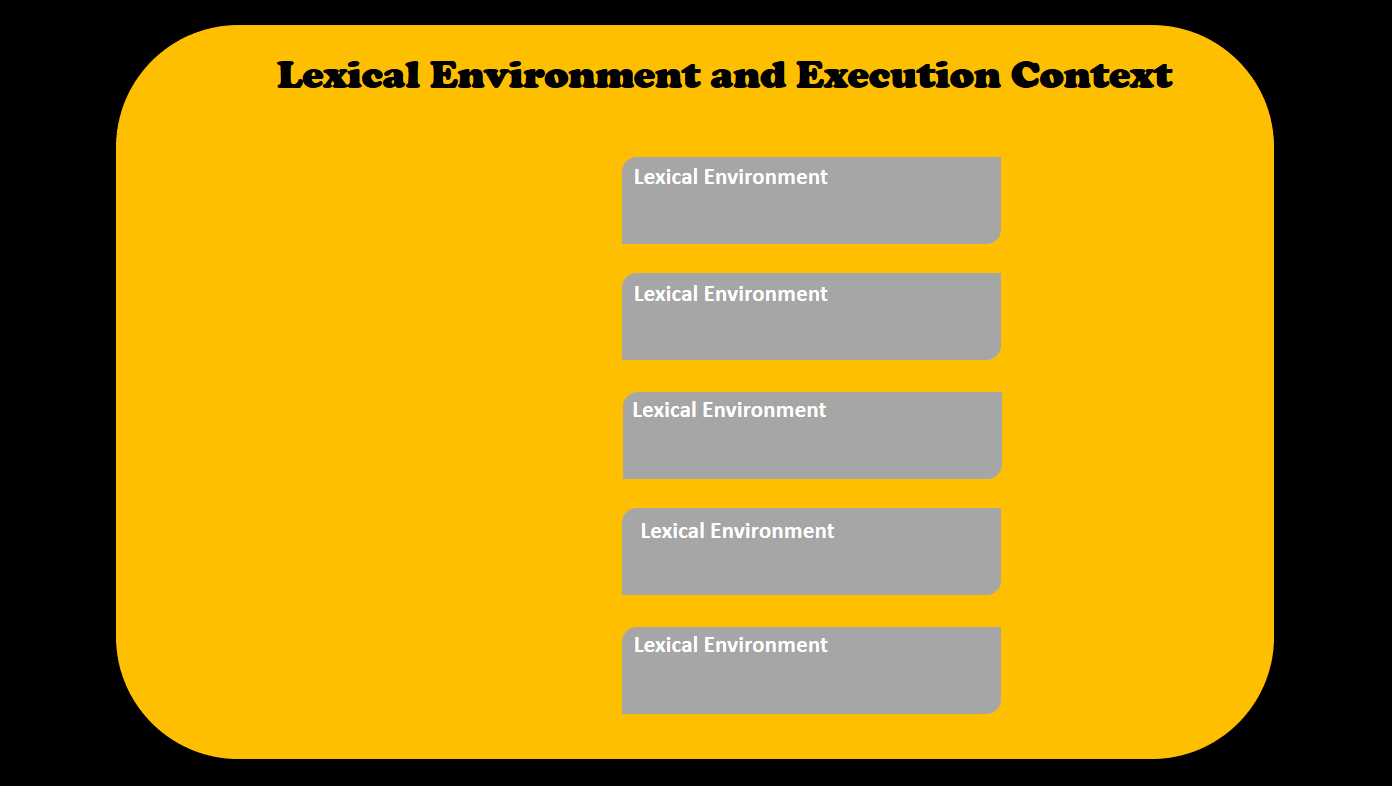JavaScript's this keyword is one of the hardest aspects of the language to grasp. But it is critically important for writing more advanced JavaScript code.
In JavaScript, the this keyword allows us to:
- Reuse functions in different execution contexts. It means, a function once defined can be invoked for different objects using the
thiskeyword. - Identifying the object in the current execution context when we invoke a method.
The this keyword is very closely associated with JavaScript functions. When it comes to this, the fundamental thing is to understand where a function is invoked. Because we don't know what is in the this keyword until the function is invoked.
The usage of this can be categorized into five different binding aspects. In this article, we will learn about all five aspects with examples.
First, What is Binding?
In JavaScript, a Lexical Environment is where your code is physically written. In the example below, the variable name is lexically inside the function sayName().
function sayName() {
let name = 'someName';
console.log('The name is, ', name);
}An Execution Context refers to the code that is currently running and everything else that helps run it. There can be lots of lexical environments available but the one that's currently running is managed by the Execution Context.

Each of the Execution Context contains an Environment Record. As JavaScript engine executes the code, variables and function names gets added to the Environment Record.
This phenomenon is known as Binding in JavaScript. Binding helps associate the identifiers(variables, function names) with the this keyword for an execution context.
Don't worry if you find this a bit hard to understand now. You will get a better grasp as we proceed.
Rule #1: How JavaScript Implicit Binding Works
Implicit binding covers most of the use-cases for dealing with the this keyword.
When we invoke a method of an object, we use the dot(.) notation to access it. In implicit binding, you need to check the object adjacent to the method at the invocation time. This determines what this is binding to.
Let's look at an example to understand it better.
let blog = {
name: 'Tapas',
address: 'freecodecamp',
message: function() {
console.log(`${this.name} blogs on ${this.address}`);
}
};
blog.message();Here this is bound to the blog object. We know this because we invoke the method message() on the blog object. So this.name is going to log Tapas and this.address is going to log freeCodeCamp in the console.
Let's see another example to better understand this concept:
function greeting(obj) {
obj.logMessage = function() {
console.log(`${this.name} is ${this.age} years old!`);
}
};
const tom = {
name: 'Tom',
age: 7
};
const jerry = {
name: 'jerry',
age: 3
};
greeting(tom);
greeting(jerry);
tom.logMessage ();
jerry.logMessage ();
In this example, we have two objects, tom and jerry. We have decorated (enhanced) these objects by attaching a method called logMessage().
Notice that when we invoke tom.logMessage(), it was invoked on the tom object. So this is bound to the tom object and it logs the value tom and 7 (this.name is equal to tom and this.age is 7 here). The same applies when jerry.logMessage() is invoked.
Rule #2: How JavaScript Explicit Binding Works
We have seen that JavaScript creates an environment to execute the code we write. It takes care of the memory creation for variables, functions, objects, and so on in the creation phase. Finally it executes the code in the execution phase. This special environment is called the Execution Context.
There can be many such environments (Execution Contexts) in a JavaScript application. Each execution context operates independently from the others.
But at times, we may want to use stuff from one execution context in another. That is where explicit binding comes into play.
In explicit binding, we can call a function with an object when the function is outside of the execution context of the object.
There are three very special methods, call(), apply() and bind() that help us achieve explicit binding.
How the JavaScript call() Method Works
With the call() method, the context with which the function has to be called will be passed as a parameter to the call(). Let us see how it works with an example:
let getName = function() {
console.log(this.name);
}
let user = {
name: 'Tapas',
address: 'Freecodecamp'
};
getName.call(user);Here the call() method is invoked on a function called getName(). The getName() function just logs this.name. But what is this here? That gets determined by what has been passed to the call() method.
Here, this will bind to the user object because we have passed the user as a parameter to the call() method. So this.name should log the value of the name property of the user object, that is Tapas.
In the above example, we have passed just one argument to call(). But we can also pass multiple arguments to call(), like this:
let getName = function(hobby1, hobby2) {
console.log(this.name + ' likes ' + hobby1 + ' , ' + hobby2);
}
let user = {
name: 'Tapas',
address: 'Bangalore'
};
let hobbies = ['Swimming', 'Blogging'];
getName.call(user, hobbies[0], hobbies[1]);Here we have passed multiple arguments to the call() method. The first argument must be the object context with which the function has to be invoked. Other parameters could just be values to use.
Here I am passing Swimming and Blogging as two parameters to the getName() function.
Did you notice a pain point here? In case of a call(), the arguments need to be passed one by one – which is not a smart way of doing things! That's where our next method, apply(), comes into the picture.
How the JavaScript apply() Method Works
This hectic way of passing arguments to the call() method can be solved by another alternate method called apply(). It is exactly the same as call() but allows you to pass the arguments more conveniently. Have a look:
let getName = function(hobby1, hobby2) {
console.log(this.name + ' likes ' + hobby1 + ' , ' + hobby2);
}
let user = {
name: 'Tapas',
address: 'Bangalore'
};
let hobbies = ['Swimming', 'Blogging'];
getName.apply(user, hobbies);Here we are able to pass an array of arguments, which is much more convenient than passing them one by one.
Tip: When you only have one value argument or no value arguments to pass, use call(). When you have multiple value arguments to pass, use apply().
How The JavaScript bind() Method Works
The bind() method is similar to the call() method but with one difference. Unlike the call() method of calling the function directly, bind() returns a brand new function and we can invoke that instead.
let getName = function(hobby1, hobby2) {
console.log(this.name + ' likes ' + hobby1 + ' , ' + hobby2);
}
let user = {
name: 'Tapas',
address: 'Bangalore'
};
let hobbies = ['Swimming', 'Blogging'];
let newFn = getName.bind(user, hobbies[0], hobbies[1]);
newFn();Here the getName.bind() doesn't invoke the function getName() directly. It returns a new function, newFn and we can invoke it as newFn().
Rule #3: The JavaScript new Binding
A new keyword is used to create an object from the constructor function.
let Cartoon = function(name, character) {
this.name = name;
this.character = character;
this.log = function() {
console.log(this.name + ' is a ' + this.character);
}
};You can create objects using the new keyword like this:
let tom = new Cartoon('Tom', 'Cat');
let jerry = new Cartoon('Jerry', 'Mouse');When a function is invoked with the new keyword, JavaScript creates an internal this object(like, this = {}) within the function. The newly created this binds to the object being created using the new keyword.
Sounds complex? Ok, let's break it down. Take this line,
let tom = new Cartoon('Tom', 'Cat');Here the function Cartoon is invoked with the new keyword. So the internally created this will be bound to the new object being created here, which is tom.
Rule #4: JavaScript Global Object Binding
What do you think will be the output of the code below? What is this binding to here?
let sayName = function(name) {
console.log(this.name);
};
window.name = 'Tapas';
sayName();If the this keyword is not resolved with any of the bindings, implicit, explicit or new, then the this is bound to the window(global) object.
There is one exception though. JavaScript strict mode does not allow this default binding.
"use strict";
function myFunction() {
return this;
}In the above case, this is undefined.
Rule #5: HTML Event Element Binding in JavaScript
In HTML event handlers, this binds to the HTML elements that receive the event.
<button onclick="console.log(this)">Click Me!</button>The is the output log in the console when you click on the button:
"<button onclick='console.log(this)'>Click Me!</button>"You can change the button style using the this keyword, like this:
<button onclick="this.style.color='teal'">Click Me!</button>But be mindful when you call a function on the button click and use this inside that function.
<button onclick="changeColor()">Click Me!</button>and the JavaScript:
function changeColor() {
this.style.color='teal';
}The above code won't work as expected. As we have seen in the Rule 4, here this will be bound to the global object (in the 'non-strict' mode) where there is no style object to set the color.
In Summary
To summarize,
- In the case of implicit binding,
thisbinds to the object adjacent to the dot(.) operator while invoking the method. - In the case of explicit binding, we can call a function with an object when the function is outside of the execution context of the object. The methods
call(),apply(), andbind()play a big role here. - When a function is invoked with the
newkeyword, thethiskeyword inside the function binds to the new object being constructed. - When the
thiskeyword is not resolved with any of the bindings,implicit,explicitornew, thenthisis bound to thewindow(global)object. In JavaScript's strict mode,thiswill be undefined. - In HTML event handlers,
thisbinds to the HTML elements that receive the event.
There is one more case where this behaves differently, such as with ES6 arrow functions. We will take a look at that in a future article.
I hope you found this article insightful. You may also like,
- JavaScript Hoisting Internals
- Understanding JavaScript Execution Context like never before
- JavaScript Scope Fundamentals with Tom and Jerry
- Understanding JavaScript Closure with example
If this article was useful, please share it so others can read it as well. You can @ me on Twitter (@tapasadhikary) with comments, or feel free to follow me.

